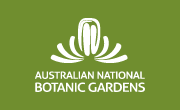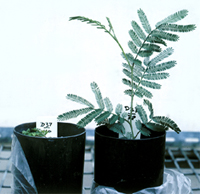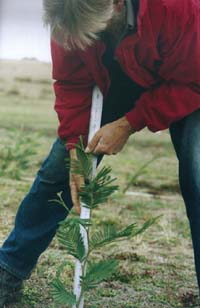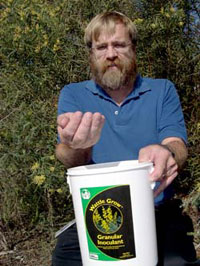Bacteria boosted wattles help 're-green' Australia
| Re-planting areas cleared of native vegetation is difficult and time consuming but critical to addressing dryland salinity and biodiversity loss on farm land. Scientists in the Centre for Plant Biodiversity Research (CPBR) in 2004 found a way to improve establishment rates and performance of newly planted wattles by using a soil bacterium called Bradyrhizobium. |
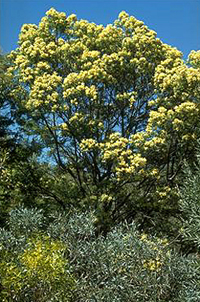 Acacia paramattensis |
|
Re-greening Australia
Native vegetation loss occurs all across Australia, especially in our agricultural regions. There is now a recognised need to strategically replant many areas with native vegetation to restore biodiversity and help combat problems like dryland salinity.
For land managers, however, replanting with native vegetation is not a simple task. There is a lack of scientific support to assist them which often results in costly and failed tree planting ventures.
Helpful relationships
Dr Peter Thrall and his team at the Centre for Plant Biodiversity Research, have demonstrated that growing wattles with a soil bacterium called Bradyrhizobium improves their chances of survival and increases their growth rates.
Many plants grow in 'symbiotic' relationships where the plant grows with another organism, like bacteria. The relationship is mutually beneficial therefore the plant and organism grow better when together than if they grew separately. The Bradyrhizobium has the special task of helping the wattle 'fix' nitrogen meaning that it can take atmospheric nitrogen and turn it into available nitrogen in the soil, which acts as a fertiliser.
In natural ecosystems Bradyrhizobium occurs where wattles grow but it is frequently absent in farm land where replanting or reseeding with native vegetation may be taking place.
Working in collaboration with the Department of Primary Industries - Victoria, the North Central Catchment Management Authority and Greening Australia Victoria, scientists in the CPBR and their CSIRO Plant Industry colleagues have established a number of large scale field trials in north-central Victoria. These trials have shown that direct seeding of wattle seed inoculated, or covered, with Bradyrhizobium has establishment rates 2 to 5 times better than untreated seed. Glasshouse trials have also demonstrated similar advantages to treated seed.
Other advantages
The CPBR's research has also demonstrated that the presence of wattles growing in symbiosis with helpful Bradyrhizobium strains also provides benefits to other plants growing nearby like eucalypts.
This will help in establishing more complete ecosystems and provide a longer term, sustainable solution.
Useful in saline conditions
|
|
Dryland salinity occurs across large areas of Australia and is considered a significant problem causing loss in farming land and reductions in yield and profitability. The area of land affected by salinity is expanding.
Replanting trees and shrubs is part of a whole farm management approach to tackle dryland salinity. Finding suitable plants that can be established and survive in saline conditions is a significant problem for land managers as not all trees or shrubs can tolerate such conditions. Furthermore the extensive nature of dryland salinity will require wide scale planting on farmland to help reduce the problem.
Wattles possess varying degrees of tolerance to saline soils. Different species of wattles are more tolerant than others and even groups of individuals within a species such as a provenance, or a group of wattles from a geographical region, may be more tolerant than those from another region.
The next step for Dr Thrall's group is to look into the effect different Bradyrhizobium strains will have on the wattle's performance in saline conditions. Through their research they hope to identify salt tolerant Bradyrhizobium strains that can be coupled with salt tolerant wattles to produce wattles that establish and perform better in saline conditions.
Now available
Wattle Grow™ Granular Inoculant, a granular seed inoculant using CPBR's research into Bradyrhizobium, has been commercialised through CSIRO Plant Industry by Bio-Care Technology Pty Ltd.
Wattle Grow™ can be applied with wattle seed prior to planting, either with seed that will be used in nurseries to establish seedlings, or with seed that will be used for direct seeding.
Wattle Grow™ is suitable to a range of South Eastern Australian wattle species including some salt tolerant ones and is available through rural suppliers and via Bio-Care Technology Pty Ltd on 02 4340 2246 or info@bio-care.com.au.
Dr Peter Thrall | |
|
Research Scientist |
|
CSIRO Plant Industry |
Phone: |
+61 2 6246 5126 |
Fax: |
+61 2 6246 5249 |
Email: |
|
![An Australian Government Initiative [logo]](/images/austgovt_canbr_90px.gif)



